I’m a day late…I know. I wasn’t really inspired by the searches when I started looking at them on Wednesday. Then I had to take Ayla to the vet because she was limping but so far things seem to be ok with her. So it’s Friday again and my body feels like it’s Wednesday. But at least it will be a pleasant shock to it this evening and tomorrow morning when it finally starts to sink in that the weekend is indeed here. And did I mention we have a container being delivered today? I can hardly contain myself – lol, no pun intended! I went into so much detail on the last few searches that I figure I’ll leave you with only 4 today. It is Friday after all 😉
- how to sanitize a chicken coop
First step of this should be not doing it yourself. Ick! 🙂 But we did so I will tell you what steps we took although I cannot be certain that all is 100% sterile now. I will say that it doesn’t smell in any way nor can I tell that there were once chickens there which makes me feel better at least. And I guess the question is whether you intend to put chicken back in the coop or if you are going to build it into something entirely different as we will be doing.
What we did was first scoop out all the bird waste into a trash container. Then we removed all the perches, benches and feed troughs from the area. Once the room was essentially bare, we began pressure washing the floors and walls with a diluted bleach solution and used the wet/dry vac to suck the water out of any poorly draining areas. Since bleach is known to kill just about everything we think this sufficed to make the area sanitary. I wouldn’t eat off the floor but I wouldn’t eat off too many floors outside anyway. You can read more about our process and see some photos here.
If on the other hand you are looking for information about sanitizing the coop while birds are living in there, I am afraid I can’t really help. But we may take on raising a few chickens at some point so maybe you can check back with us 🙂
- several baby birds swallows falling out of nest
As many of you have read, we have had some very interesting interactions with the birds around our farm this year. We have 8 swallows nests and 1 blackbird (Amsel) nest around the courtyard. The blackbirds held us hostage for a while as the 3 babies learned to fly and we ultimately lost one in the end. The swallows were an even sadder story. Three or four of our nests are occupied this year and those bird families all had babies. I am not certain how many nests are occupied exactly because the nests are behind some beams and I cannot manage to see the nests when there are actually birds in them.Not quite a month ago I went outside one morning after the dog had been acting strange and saw that 8 or so swallow babies had tragically landing on the concrete and left this world. I have no idea how long they might have been there but there was no saving any of them. I thought at the time that perhaps a marten or something had gotten to them…but it could have also just been natural selection.
I was reading a rather interesting forum post about barn swallow babies and have come up with the following conclusion: baby swallows are either massively stupid or just not nice to each other. Swallows falling out of their nests seems to be a common dilemma and apparently even if you rescue them and put them back in the nest, they are likely to fall out once again. I guess it’s not really a big surprise that these little guys would start falling out. The nests are tiny and the parents are raising 3-4 birds in each nest. I think the one nest where no one got shoved out was simply because it was so close to the ceiling that they couldn’t easily fall out.
Sometimes the runts of each family flock will get booted by the stronger birds in a survival of the fittest measure. The mama birds may also dump the flock from time to time if they are diseased or she feels that they will not survive for some reason. It could also happen that a foreign bird lays his eggs in another bird’s nest and the mother will toss them out because they are not her own. And then there are some baby birds which apparently seem to think they are ready to fly, will walk off the edge of the nest, realize they actually have no idea how to fly and then hit the ground. Or perhaps they just slip out over the edge before they even think about flying.
Anyway you look at it, being a swallow is apparently not an easy life to live. If you manage to survive until you learn to fly, you then have to watch out for cats, snakes and other predators, learn to migrate for the winter and then hope that when you come back “home” the following year someone hasn’t destroyed your nest because they no longer want you there. The more I read about these birds, the worse I feel about getting rid of the nests we have, even if it’s only a portion of them. Thankfully we don’t have to make that decision now, though.
- making my american weber grill work in germany
I have to assume that this would be a gas grill that they are looking for answers about and I truly wish I had an answer. We have an American gas grill (sadly not a Weber but maybe one of these years) and our gas tank is now empty. I have been hounding Stefan about going to have it filled for a while now just so we can test whether they can actually fill the thing or not. Our friends who were here working with the Army left the grill for us when they moved back to the States. We attempted to find an adapter that would allow us to use a German gas bottle on the grill but could only find adapters that allowed German grills to use foreign gas bottles. We have never tried using a German bottle on the grill either but perhaps we will find some time to take this on while Stefan is on vacation next week. Although we both prefer using charcoal, gas is so much faster and great if you want to throw a few steaks on the grill after work one night…and what good is the gas grill if we can’t use it at all??
- timber framing germany
I’ve written quite a bit about half-timbering and architecture styles but something I haven’t mentioned is that there are many different styles of timber framing in Germany which vary by region. In fact, there is a special tourism office and a rather informative website just for towns with timber framed houses and they have a special collection of streets around Germany which lead through many of these towns. The German Fachwerk (timber frame) Road is actually a collection of roads as you can see on this map below. 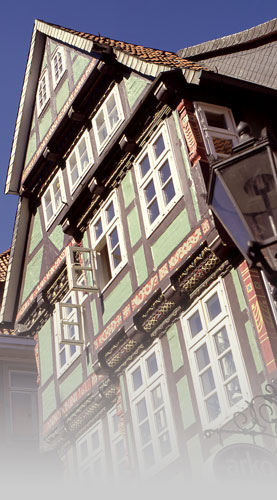
So here is what I learned from their website about half-timbered houses in Germany which I also didn’t know. Our house is characteristically Central German Framework. I also ordered some information about the various regions of this route because I would really like to see more of it and get a better perspective on the differences of the architecture from region to region.
Lower German Framework
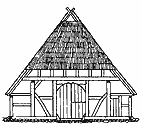
gn=”right” border=”0″ /> is characterized by two- and four-column constructions for large hangar-houses with a central hall accessible from the street. The ground plan of these houses consists of three naves. Originally, the side naves were sheds, the central nave was the hall and the bedrooms faced the garden. Especially in towns, the basic ground plan was changed early whereby the typical “Utluchten” developed. |
Central German Framework
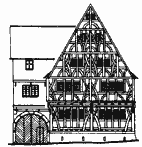 is spread in all medium-altitude mountains as far as the Neckar in the south, to Poland in the east and to the French Alsace in the west. Mostly, the gables of these houses face the street and the latter are divided into zones: the “parlour” is in front, then come the kitchen and stairway and the bedrooms are in the back. Sheds, the crop storage and the bakehouse were mostly in separate buildings and in larger settlements the houses were adapted to urban conditions. is spread in all medium-altitude mountains as far as the Neckar in the south, to Poland in the east and to the French Alsace in the west. Mostly, the gables of these houses face the street and the latter are divided into zones: the “parlour” is in front, then come the kitchen and stairway and the bedrooms are in the back. Sheds, the crop storage and the bakehouse were mostly in separate buildings and in larger settlements the houses were adapted to urban conditions. |
Upper German Framework
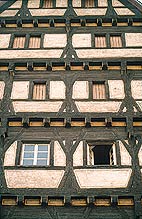 In the region between the river Neckar and Lake Constance, Black Forest and Bohemian Forest an independent type of house with wide column positions and double frame beams developed from the Alemannic floor-type building in 14th century. In 15th and 16th century more and more construction methods were adopted from Central Germany until the basic construction methods became identical about 1600. In the region between the river Neckar and Lake Constance, Black Forest and Bohemian Forest an independent type of house with wide column positions and double frame beams developed from the Alemannic floor-type building in 14th century. In 15th and 16th century more and more construction methods were adopted from Central Germany until the basic construction methods became identical about 1600. |
Andrew’s Cross
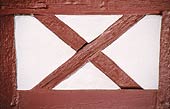 As a sign for multiplication, our early ancestors, the Germanic people, used “the other cross” which we still use in calculators. In Christian times, the other cross was re-interpreted as St. Andrew’s cross commemorating holy St. Andrew. In the flared form, St. Andrew’s cross is also called ‘firedog’. As a sign for multiplication, our early ancestors, the Germanic people, used “the other cross” which we still use in calculators. In Christian times, the other cross was re-interpreted as St. Andrew’s cross commemorating holy St. Andrew. In the flared form, St. Andrew’s cross is also called ‘firedog’. |
Fanned Rosette
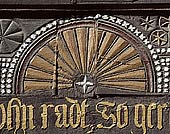 Especially in Lower Germany, the fanned rosette appears as an ornamental motif in the first third of 16th century and adopts a dominant role as breast apparel in the following centuries. The origin is supposed to be the shape of a shell but also symbols of the sun. Especially in Lower Germany, the fanned rosette appears as an ornamental motif in the first third of 16th century and adopts a dominant role as breast apparel in the following centuries. The origin is supposed to be the shape of a shell but also symbols of the sun. |
Grudger Heads
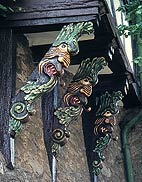 In the Middle Ages, one of the evils against which one had to defend oneself was not only “the evil eye” but also envy. Therefore “Grudger Heads”, frowning heads or figures sticking out their tongues to grudgers, were fixed on the front of framework houses. In the Middle Ages, one of the evils against which one had to defend oneself was not only “the evil eye” but also envy. Therefore “Grudger Heads”, frowning heads or figures sticking out their tongues to grudgers, were fixed on the front of framework houses. |



 is spread in all medium-altitude mountains as far as the Neckar in the south, to Poland in the east and to the French Alsace in the west. Mostly, the gables of these houses face the street and the latter are divided into zones: the “parlour” is in front, then come the kitchen and stairway and the bedrooms are in the back. Sheds, the crop storage and the bakehouse were mostly in separate buildings and in larger settlements the houses were adapted to urban conditions.
is spread in all medium-altitude mountains as far as the Neckar in the south, to Poland in the east and to the French Alsace in the west. Mostly, the gables of these houses face the street and the latter are divided into zones: the “parlour” is in front, then come the kitchen and stairway and the bedrooms are in the back. Sheds, the crop storage and the bakehouse were mostly in separate buildings and in larger settlements the houses were adapted to urban conditions. In the region between the river Neckar and Lake Constance, Black Forest and Bohemian Forest an independent type of house with wide column positions and double frame beams developed from the Alemannic floor-type building in 14th century. In 15th and 16th century more and more construction methods were adopted from Central Germany until the basic construction methods became identical about 1600.
In the region between the river Neckar and Lake Constance, Black Forest and Bohemian Forest an independent type of house with wide column positions and double frame beams developed from the Alemannic floor-type building in 14th century. In 15th and 16th century more and more construction methods were adopted from Central Germany until the basic construction methods became identical about 1600. As a sign for multiplication, our early ancestors, the Germanic people, used “the other cross” which we still use in calculators. In Christian times, the other cross was re-interpreted as St. Andrew’s cross commemorating holy St. Andrew. In the flared form, St. Andrew’s cross is also called ‘firedog’.
As a sign for multiplication, our early ancestors, the Germanic people, used “the other cross” which we still use in calculators. In Christian times, the other cross was re-interpreted as St. Andrew’s cross commemorating holy St. Andrew. In the flared form, St. Andrew’s cross is also called ‘firedog’. Especially in Lower Germany, the fanned rosette appears as an ornamental motif in the first third of 16th century and adopts a dominant role as breast apparel in the following centuries. The origin is supposed to be the shape of a shell but also symbols of the sun.
Especially in Lower Germany, the fanned rosette appears as an ornamental motif in the first third of 16th century and adopts a dominant role as breast apparel in the following centuries. The origin is supposed to be the shape of a shell but also symbols of the sun. In the Middle Ages, one of the evils against which one had to defend oneself was not only “the evil eye” but also envy. Therefore “Grudger Heads”, frowning heads or figures sticking out their tongues to grudgers, were fixed on the front of framework houses.
In the Middle Ages, one of the evils against which one had to defend oneself was not only “the evil eye” but also envy. Therefore “Grudger Heads”, frowning heads or figures sticking out their tongues to grudgers, were fixed on the front of framework houses.

If it helps, I did a little write up about our eggplants as well.
http://1916home.blogspot.com/2007/07/growing-eggplant-recipe-too.html
Its now two weeks later and they are growing like crazy! I cant wait for whatever they produce for us! Amazing. 🙂